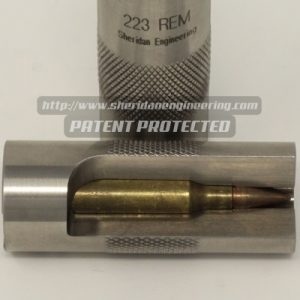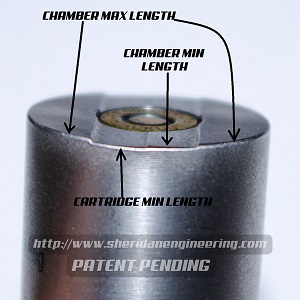This category covers the function and use of the gauges
What does it tell me if my ammo doesn’t fit the Slotted Ammunition gauge?
The gauge is made to SAAMI specs (when applicable). This includes both length measurements like the OAL and headspace, as well as the case diameters. If the brass does not fit all the way in, it could be because one of the length measurements is off, or it could also be because of a diameter is too long. Not fitting the gauge tells you that you need to inspect these rounds more closely.
By looking at the cartridge through the slot you can see where the problem is, by seeing what is making contact in the gauge. It could be a problem with headspace, or body diameters, brass trim length, or bullet seating. All of these could cause the ammo to stick up out of a standard gauge and you couldn't tell what was causing it. But the slot allows you to quickly ID which of those problems you have.
Note that the trim length for shouldered cases is not displayed.

How does the Slotted Ammunition Gauge work?
The basic function of the gauge is the same as the standard gauge. If you drop a round in, it should drop in freely, and the top of the case should sit somewhere above the bottom step and below the top step on the face of the gauge. If it is somewhere in that range, it should fit into your firing chamber without any issue. The patented slot down the side of the gauge allows you to check that everything is seating properly into the chamber. So you can visually inspect the cartridge and see that everything fits in the chamber the way it should.
What does it tell me if my ammo doesn’t fit the Ammunition Gauge?
The gauge is made to official released cartridge/chamber specs (SAAMI/CIP where applicable). This includes both length measurements like the OAL and headspace, as well as the case diameters. If the brass does not fit all the way in, it could be because one of the length measurements is off, or it could also be because of a diameter is too large. The gauge tells you that you need to inspect these rounds more closely.
Looking at the steps on the face of the gauge, they indicate the chamber min and max length (as shown on SAAMI drawings), and the spec min cartridge headspace length. By sizing the cartridge to be at/below the chamber min(middle step), that ensures that the ammo should fit any chamber in that caliber. And by sizing it to be longer than the cartridge min length(shortest step) that means that it will be be a good fit, and it shouldn't have any issues related to sizing.
Note that the trim length for shouldered cases is not displayed.

How does the Ammunition Gauge work?
The basic function of the gauge is just as simple as it seems. If you drop a round in, it should drop in freely, and the top of the case should sit somewhere above the bottom step and below the middle step on the face of the gauge. If it is somewhere in that range, it should fit into an in spec firing chamber without any issue.
Because this is designed to check that your brass will fit in ANY chamber, it is not recommended for use when the brass is only neck sized. Neck sizing is commonly done with bolt actions, where the goal is increased brass life by minimizing the amount of reworking done to the brass. While neck-sized ammunition should fit the chamber of the rifle it was fired in, it may not fit other rifles, and likely will not fit in the gauge.
Ammunition used in semi automatic rifles is typically full length sized for reliable feeding/chambering. This ammunition gauge is designed to work with full length sizing.
